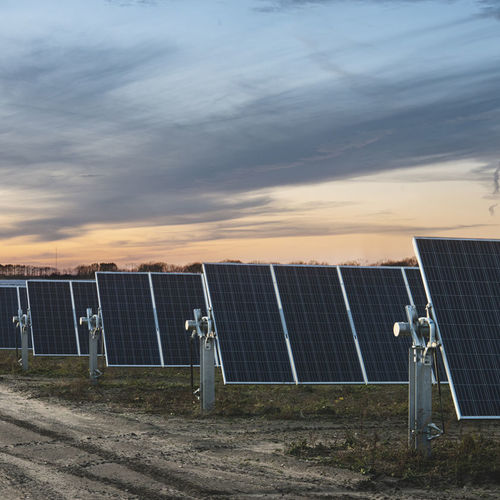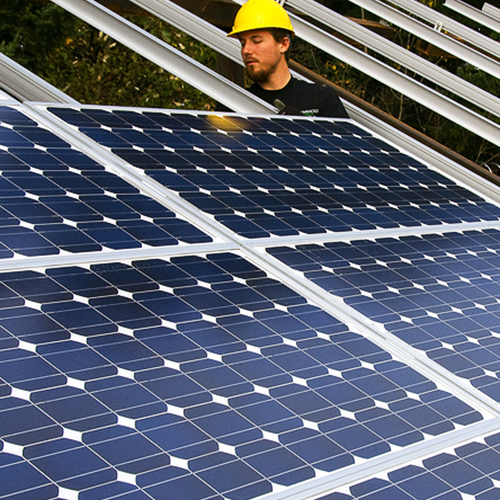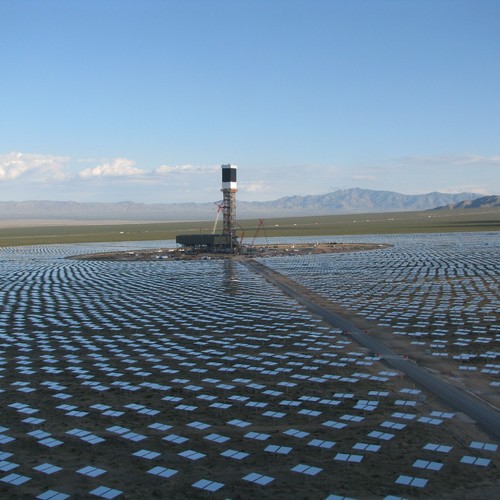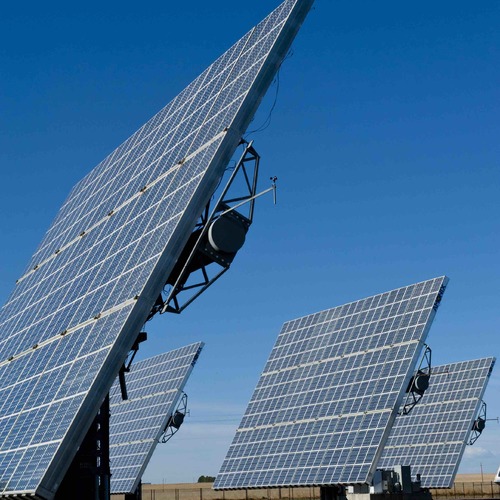
Image Credit: Alex Wilson
Image Credit: Alex Wilson The Nellis Air Force Base PV installation provides a quarter of the facility's power requirements.
Image Credit: Nellis Air Force Base An aerial view of the entire 14.2-MB solar facility at Nellis Air Force Base.
Image Credit: Master Sargent Rovert Valenca, Nellis AFB The 2-MB rooftop PV array installed at Schüco's U.S. offices outside Hartford, Connecticut.
Image Credit: Schüco A detail showing the building-integrated PV (BIPV) module that Schüco used in its Connecticut installation.
When the economy-of-scale with wind power [no-glossary]led[/no-glossary] to larger and larger wind turbines, opponents of these installations took to referring to them as “industrial wind power.” Whenever I see a letter-to-the-editor or news story that uses this phrase, I can tell that it’s going to have an anti-wind bias.
Whether its marring their views of pristine mountains, blighting their night sky with blinking red lights, causing bird and bat fatalities, or producing the somewhat mythical “infrasound,” opponents almost universally refer to these wind farms using an industrial moniker.
So, I’m becoming troubled by recent reference to “industrial solar” in describing the larger photovoltaic (PV) installations that are cropping up in Vermont and nationwide. Some opposition seems to be emerging, for example, to a 2 megawatt (MW) array that’s being proposed for Brattleboro, and I’m hearing more and more such concerns nationally.
The economy of scale with solar
As with wind, there is an economy-of-scale with solar-electric systems. Bulk purchase of solar modules brings the costs down somewhat and, more significantly, larger inverters (the devices that convert direct-current electricity produced by PV modules into the alternating current that can be fed into the utility grid) and other balance-of-system components are a lot less expensive per kW or MW of capacity than the residential-scale components being installed for home systems.
But the differences in cost between large and small systems aren’t nearly as great with PV systems as they are with wind turbines. This means that the incentives for building very large solar systems (“industrial-scale” if you must) aren’t as great as they are with wind.
Advantages of smaller PV systems
Despite the (relatively minor) economy-of-scale that argues for larger PV systems, there are some benefits of small systems.
For starters, small systems are well-suited to rooftops. A typical house, if it has a reasonable orientation, can hold a 4-6 kW solar array, enough to handle a significant fraction of the home’s power consumption (as long as then home is reasonably energy-efficient). And commercial buildings, with large flat roofs can often hold hundreds of kW or even a MW or two of solar — which can provide a significant fraction of those buildings’ electrical demands.
Putting solar modules on roofs creates headaches with roof maintenance, and poor-quality installations sometimes result in roof leaks, but rooftop mounting allows us to preserve land area for agriculture, recreation, and wildlife habitat. Whenever possible, I prefer to see PV systems installed on rooftops or carports rather than ground-mounting, though I recognize that that isn’t always possible or practical.
Small PV systems also usually generate electricity close to where it is being consumed. Such “distributed power” is changing the face of the utility grid. From a resilience standpoint, generating power close to the point of end-use of electricity also opens up an opportunity for incorporating either some battery storage or specialized inverters with capability to draw power from the solar system even when the grid is down — something that most grid-connected solar systems can’t do today. (For more on that, refer back to my blog, Getting Power From Solar Equipment When the Grid is Down.)
Is big solar bad?
Not in my book. As I look toward the future and a growing imperative to dramatically reduce our fossil fuel consumption and carbon dioxide emissions, I’m convinced that we need a mix of facility sizes with renewable energy systems. There will be many places where large, ground-mounted multi-megawatt-scale solar systems make sense, such as along highways and utility corridors where the land is already degraded and agriculture may not be feasible.
In arid places with lots of open land, such as the American Southwest, it should be possible for large solar systems to be developed responsibly — as long as enough open space is maintained for wildlife.
This isn’t to say that huge arrays make sense everywhere, just as wind turbines don’t belong everywhere. Having served as a trustee of the Vermont Chapter of The Nature Conservancy for nine years, I am well aware of the need for natural, undisturbed habitat.
But I’m also aware that if we don’t address our greenhouse gas emissions, we will be doing far more damage to ecosystems than the solar arrays (and wind farms) that are coming under more widespread attack.
Alex is founder of BuildingGreen, Inc. and executive editor of Environmental Building News. In 2012 he founded the Resilient Design Institute. To keep up with Alex’s latest articles and musings, you can sign up for his Twitter feed.
Weekly Newsletter
Get building science and energy efficiency advice, plus special offers, in your inbox.















12 Comments
If we do it right, hopefully skeptics will embrace big solar
What makes me hopeful is that solar arrays can be beautifully integrated into architecture, and can even provide added value in the form of shade structures or carports. I truly wonder why the idea of covering parking lots with solar arrays hasn't caught on. It seems like a no-brainer, or maybe I'm missing something.
Only about 25%...
... of residential & commercial rooftops in the US are suitable for rooftop PV according to National Renewable Energy Laboratory estimates. But as the price of PV plummets (currently in the $4/watt range all-in unsubsidized installed cost for sub 10KW grid tied, headed for sub $2/watt by 2020), even sub-optimal orientations and shading factors become cost-effective if net-metered at fixed-price residential retail.
From a grid operator's point of view west-facing roof pitches are more valuable than south facing pitches that produce more total power, since the timing of the peak output meshes better with peak air condition loads, reducing the amount of spinning peak reserve capacity required. What was considered "appropriate" in 2012/2013 terms may expand pretty rapidly if net metering models evolve to reflect the value of load-peak output.
The value to the grid of having the peak-load generation distributed and near the load (rooftop model) rather than centralized (industrial model) is significant too, and from a total grid economic point of view the reduce size of the other grid infrastructure requirements more than offsets any economy of scale of the large centralized solar farm model, at least most of the time. Studies performed by/for the publicly owned utility in Austin TX has become the model for more sophisticated compensation models than the rough-justice "run the meter backwards" net metering model that is the most common legacy version. California is experimenting with distributed storage to complement the rapidly expanding PV sources (already closing in on 10% of the CA grid supply!), and at some level of rooftop PV saturation, local storage may become mandatory for any new PV, to be able to better stabilize the local grid.
Solar parking lots and PV fed electric car charging station/parking is beginning to show up in CA, particularly in areas where electric cars are being promoted heavily by local municipalities. But even in less-sunny (but solar-subsidized) MA there are existence proofs of the suburban PV-parking lot concept:
http://www.rei.com/share/rei-blog/2012/08/from_asphalt_to_elec.html
the importance of scale
Alex,
You touch briefly on the fact that there are few economics of scale with solar than with wind, but surprisingly you do not talk about the more fundamental issue, which is that small-scale wind power almost never makes sense. In fact, it often doesn't break even energetically, much less economically.
http://www.lowtechmagazine.com/2009/04/small-windmills-test-results.html
And this is something you have written about in the past
http://www2.buildinggreen.com/blogs/wind-power-why-it-doesn-t-make-sense-everywhere
There's a very good reason for this: a small turbine has a smaller swept area, which means that it simply cannot harvest as much energy. Since swept area goes as the square of blade length, this is a powerful effect.
Small scale wind...
...sorta depend on what you MEAN by that, and which side of the meter it is on.
While residential roof-ornament type micro-scale wind will never make sense for a grid-tied home, the ~100kw small-campus turbine can come in at a positive net-present value in high electricity cost moderate-wind locations when net metered at retail, even though the same turbine would be cost-prohibitive from a windfarm power perspective. Commercially viable grid-wind come in chunks of megawatts per turbine.
The comparative scalablity and low maintenance of PV will continue to make it the every more cost-effective option at the single-family residential level.
Micro-cogeneration is viable in high electricity cost heating-dominated climates for homes on the gas grid, but the options in US are still comparatively few. There are well over 100,000 of the ~kilowatt-Honda cogenerators already on-grid in Japan, and the options in norther Europe seem to be growing too. They were available in the US for awhile married to a gas-fired furnace or hydronic boiler under the name "Freewatt", but since being bought up by ECR International the marketing of the Freewatt systems seems to have fizzled. (A guy in my office heats his house with one of the hydronic boiler versions.) The economics of the Freewatt vs. condensing gas furnaces do not always work out so well due to the low thermal efficiency of the unit as purely a generator- but it worked somewhat more favorably for hydronic heating systems.
http://www.cdhenergy.com/presentations/Freewatt%20Report%20-%20October2011.pdf
But when micro-cogenerators are sized to better match the thermal loads of homes it can still pencil-out favorably, at is happening in Northern Europe where both electricity & natural gas are more expensive than in the US.
Dana
Yes, quite right. I was really talking about residential scale (sub 100kW). I can see how stuff in the 100kW-1MW range might work on a neighborhood level. As we (hopefully) start seeing more regional microgrids, that kind of generation may become more popular.
That's about it- for example...
In Worcester MA there is parochial high school located at the top of a hill where they did the math and installed a 600kw turbine. It's annual output is more than the campus uses, and even though the wind resource isn't "commercial grade", by having it on THEIR side of the meter it made economic sense:
http://www.wpi.edu/Pubs/E-project/Available/E-project-121306-104131/unrestricted/Holy_Name_IQP.pdf
http://worcestermag.com/2010/09/16/the-greening-of-worcester-102980354/6669
The well kept "secret" is just how much cheaper and better the sub-megawatt turbines have gotten even since that one was installed. With reasonable financing structures this type of project can be viable in many many locations with only moderate wind resources.
Medium scale PV
My own sense is that medium scale PV offers the best mix between distributed generation and centralized solar farms.
On my street the tree cover is such that individual house PV would be sheer folly, and since we are in the deep South it would also be folly to fell the trees.
All that said, it would seem to make sense for 100-1000 shaded homeowners to band together and invest in one or more medium scale PV installations at community schools or shopping centers where economies of scale may be realized and shading is not a problem. Indeed, I would treasure being able to park in the shade of a PV canopy while buying groceries, household goods, or contracting supplies.
The typical big box supercenter or LowesDepot has 100,000 - 250,000 SF of flat, completely unshaded roof area regularly punctuated with 3 phase disconnects serving rooftop HVAC units. From a scaled up PV installation point of view, what's not to like about that set of circumstances?
The box store roof tops...
...are certainly already among the 25% cited by NREL surveys, and already financially viable at national average commercial retail rates, prompting those businesses to use that space for their own purposes. (Wal-Mart has been the trend-setter on that front: http://www.bloomberg.com/news/2013-10-24/wal-mart-now-has-more-solar-than-38-u-s-states-drink-.html ) The reduction in cooling power requirements and extended longevity of the now-shaded flat roof are a significant part of the equation for them, beyond offsetting power use simply by the power produced.
Community level photon-farming of the parking lots may be possible, but if the electric vehicle introduction curve continues it's exponential rise I would expect those businesses to invest in "free" PV car-charging ports as perk for attracting customers. But there is indeed a lot of paved parking in urban/suburban areas suitable for photon-farming at comparatively low cost once the all-in cost crosses the sub $2/watt boundary, which it almost certainly will in less than a decade.
To be sure houses on tree lined streets such as Curt's (& mine) are currently part of NRELa 75%. My home's solar survey indicates a shading factor that would deliver at best ~60% power production of what would be possible without the trees), but at some PV price point even that 60% becomes financially viable, but not the sweet juicy plum being chased by third-party solar companies. (Third party ownership of rooftop PV is allowed in my state, but not in Curt's.)
According the analysts at GreenTechMedia sifting all of the state, federal and private company numbers, the installed base of PV is doubling in the US every 2.5 years, and even as subisidies get scaled back there is evidence that the exponential growth will continue for at least a decade, possibly two, as the lifecycle cost per kwh is soon to become the cheapest power source currently available. Innovations in financing (such as the third-party ownership models) have been part of it, but it is by no means the only driver. It's taking awhile for people to get over the notion that PV solar is expensive (only a decade ago it really was expensive!), but it's at retail-power price-parity now, and going forward it's going to be dirt-cheap.
And the thin edge of the wedge gets thicker...
According to this blog bit, with streamlined permitting the cost of small and mid-scale PV in Iowa is now running $3-3.50/watt, installed. With subsidies applied the ROI is now under a decade for most installations.:
http://www.greentechmedia.com/articles/read/move-over-wind-solar-energy-market-exploding-in-iowa
The PV genie is almost completely out of the bottle now, and it will be disruptive of more than just aesthetics. Prepare for some radical adjustments in the net-metering/compensation deals!
Farm PV
Another option around here in corn/wheat farming country is that farmers can install 20 kW PV systems with the grid intertie. The systems are installed on the ground near the buildings which simplifies installation. The space used is tiny but it helps with the electric bills.
This could be a great source of income for farmers and ranchers - and other land uses could be incorporated (pasture or hay for example) within the installation if it's designed properly. The current max system size for our electric coop is 20 kW but bigger systems could easily be installed for medium scale distributed generation with some policy changes. I really see this as a winning situation for everyone.
report on solar YIMBY
This just came into my email inbox.
Please, in My Backyard:
How renewable energy cooperatives advanced citizen involvement in the Germany energy transition
http://boell.org/data/audio/climate-transatlantic/publications/Wieg_Please_in_my_backyard.pdf [PDF]
YIMBY
Jonathan,
I attended one of Andreas Wieg's presentations this past year (at World Learning in Putney, VT) on the Heinrich Böll Foundation speaking tour, and found it very interesting. It was amazing how when the ownership model changed to the public owning a renewable energy installation, attitudes changed dramatically.
Log in or create an account to post a comment.
Sign up Log in